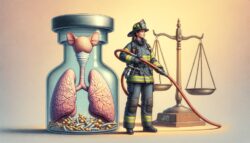Navigating Settlements: AFFF-Linked Testicular Cancer Compensation Guide
The intricacies of securing compensation for testicular cancer linked to Aqueous Film Forming Foam (AFFF) exposure are multifaceted, involving a deep understanding of both the legal landscape and the medical evidence connecting PFAS chemicals to health risks. Our comprehensive guide serves as an essential resource for affected individuals, outlining the necessary steps to navigate settlement negotiations and legal proceedings. However, the path to obtaining justice and compensation is fraught with challenges, including identifying qualified legal representation and understanding recent legal precedents. As we explore the nuances of these cases, one must consider the broader implications for environmental health and safety regulations.

Key Takeaways
- AFFF exposure with elevated PFAS levels significantly increases the risk of developing testicular cancer.
- Legal actions for compensation focus on manufacturers like DuPont and 3M for their role in PFAS contamination.
- Successful claims require documented AFFF exposure, a testicular cancer diagnosis, and a clear link between the two.
- Settlements range from $75,000 to $325,000, highlighting the importance of expert legal guidance in claim negotiations.
Understanding AFFF and Testicular Cancer
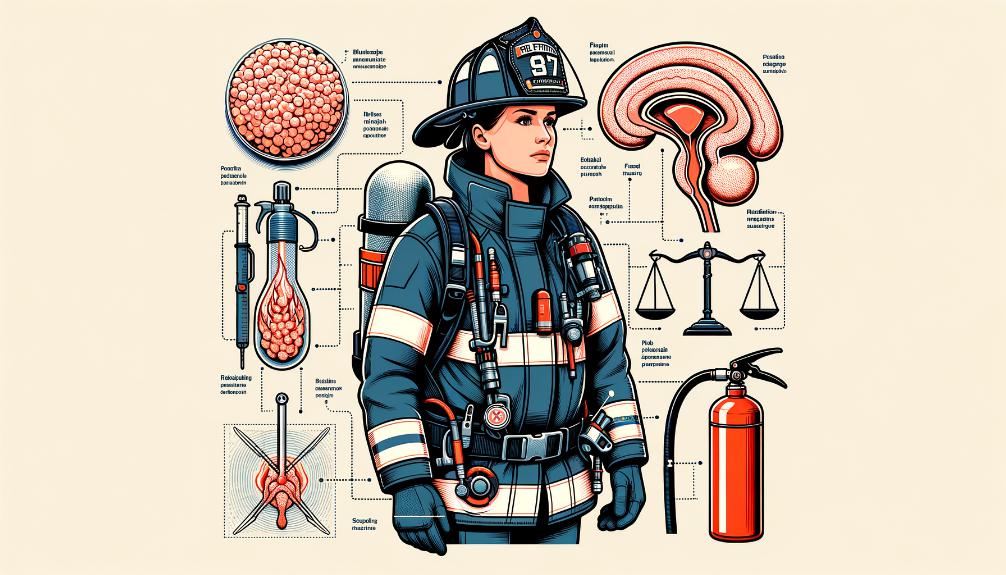
Aqueous Film-Forming Foam (AFFF), known for its firefighting efficacy, has been linked to an increased risk of testicular cancer due to its content of per- and poly-fluoroalkyl substances (PFAS). These chemicals, known for their durability and resistance to water, oil, and heat, have made AFFF an essential tool in suppressing difficult fires, particularly those involving flammable liquids. However, the very properties that make PFAS valuable in firefighting foams have also raised substantial health concerns. Studies have consistently demonstrated a correlation between PFAS exposure and an elevated risk of testicular cancer. Men with higher levels of PFAS, especially perfluorooctane sulfonate (PFOS), in their system, may face a higher likelihood of developing this malignancy.
The link between AFFF exposure and testicular cancer has prompted a reevaluation of the use of firefighting foam, especially in training exercises and actual fire suppression scenarios where individuals might come into direct contact with PFAS-laden substances. In light of these concerns, there have been movements toward settlements and compensation for affected individuals. Those who have been exposed to AFFF and subsequently diagnosed with testicular cancer are increasingly seeking legal recourse to obtain compensation for their medical expenses, suffering, and other associated costs.
The discussion around AFFF, PFAS, and testicular cancer risk highlights the need for heightened awareness and preventive measures to mitigate exposure. Moreover, it highlights the importance of pursuing settlements and compensation for those adversely affected by these substances. As more studies shed light on the connections between AFFF exposure and testicular cancer, the push for accountability, safer alternatives, and ample compensation for victims continue to gain momentum.
Recent Studies and Findings

Recent research has established a noteworthy link between exposure to PFAS, particularly PFOS, and an elevated risk of developing testicular cancer. This connection has become a focal point in the dialogue surrounding AFFF lawsuits, as individuals exposed to firefighting foam or contaminated water seek compensation for their suffering. The findings indicate that testicular cancer is more prevalent among men with high PFAS levels, drawing a clear line between PFAS exposure and the increased risk of this malignancy.
Further scrutiny reveals that analysis of data from over 1,000 Air Force members has highlighted the association between high PFAS levels, often resulting from firefighting activities or contaminated water sources, and testicular cancer risk. The value of this correlation cannot be overstated, as it demonstrates the vulnerability of individuals in certain occupations or environments to the harmful effects of PFAS.
The risk of testicular cancer escalates with prolonged exposure to PFAS, with cumulative effects observed over time. This gradual accumulation emphasizes the insidious nature of PFAS exposure and the importance of ongoing monitoring and research. Emerging evidence suggesting a potential link between PFAS exposure and a higher incidence of testicular cancer further emphasizes the need for comprehensive studies to explore this relationship thoroughly.
As studies continue to indicate that men with elevated PFAS levels may face an increased risk of developing testicular cancer, the importance of understanding and addressing PFAS exposure concerns becomes increasingly clear. This growing body of evidence serves as an important basis for AFFF lawsuits, advocating for the rights and health of affected individuals.
Health Risks of AFFF Exposure

Exposure to Aqueous Film-Forming Foam (AFFF) has been closely linked to a spectrum of health risks, notably an increased likelihood of developing testicular cancer due to the presence of per- and polyfluoroalkyl substances (PFAS). These chemicals, found in AFFF, have raised considerable concerns due to their association with several forms of cancer, with testicular cancer presenting a particularly alarming risk. Research indicates a disturbing correlation between PFAS exposure, especially perfluorooctanesulfonic acid (PFOS), and the incidence of testicular cancer. This risk appears to be exacerbated by prolonged exposure to these harmful substances, underscoring the danger they pose to individuals exposed to AFFF.
Further studies have revealed that men with elevated levels of PFAS in their systems may face a higher risk of developing testicular cancer, pointing to a dose-response relationship between PFAS exposure and cancer risk. However, the precise causal mechanisms linking PFAS exposure to the development of testicular cancer remain elusive, signaling a need for continued research in this area. The complexity of these chemical interactions and their effects on human health necessitates a deeper understanding to effectively address and mitigate these risks.
The findings to date show the cumulative effects of PFAS on the human body, with prolonged exposure leading to an increased risk of testicular cancer. This body of evidence highlights the urgent need for ongoing research to fully comprehend the scope of health risks associated with AFFF exposure and the specific role of PFAS chemicals in the development of cancer, particularly testicular cancer.
Identifying Eligible Individuals
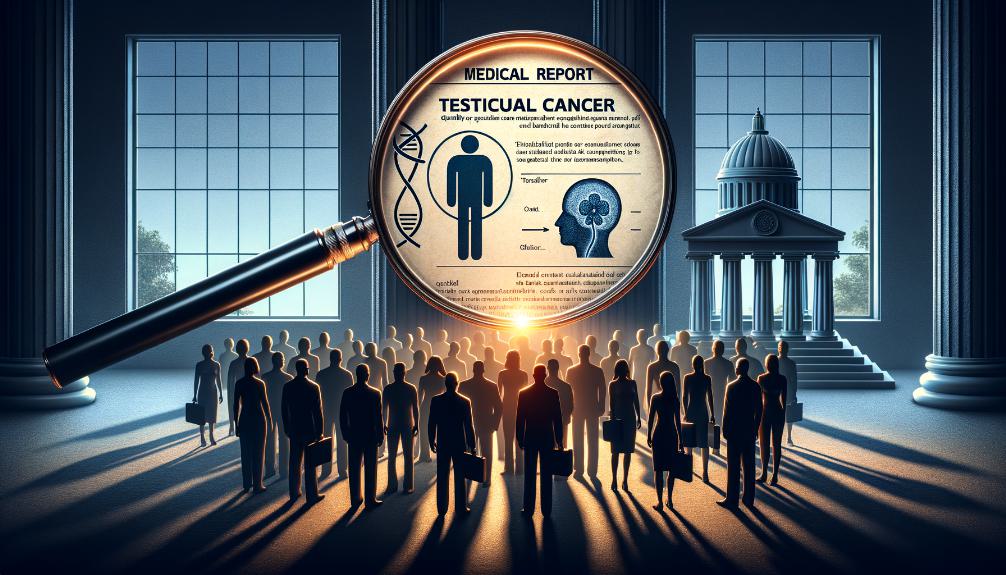
Determining who qualifies for compensation due to AFFF-linked testicular cancer hinges on several critical criteria, including a confirmed diagnosis and documented exposure to the firefighting foam. Eligible individuals encompass those who have received a testicular cancer diagnosis, underpinning the gravity of the health impact associated with AFFF chemicals. Particularly, military personnel and firefighters who have been at the frontline, confronting flames with AFFF, may find themselves navigating the complexities of compensation eligibility due to their heightened risk from occupational exposure.
Moreover, residents living in proximity to areas where AFFF was routinely used also fall into the category of those with documented exposure, potentially paving their way to compensation. The essence of eligibility hinges not only on the diagnosis but also on the history of prolonged exposure to AFFF chemicals, highlighting the relationship between occupational or residential proximity to AFFF and the development of testicular cancer.
The eligibility criteria are meticulously designed to ensure that only those with a direct link between their testicular cancer diagnosis and AFFF exposure are considered. This process, while stringent, ensures that the compensation mechanism remains fair and targeted towards those genuinely affected by AFFF chemicals. For many, navigating the eligibility criteria and the subsequent steps toward securing compensation can be daunting. This is where legal assistance becomes invaluable, offering guidance and support through the intricate journey of asserting one's rights and seeking justice for the harm endured due to AFFF exposure.
The Legal Landscape of AFFF Lawsuits
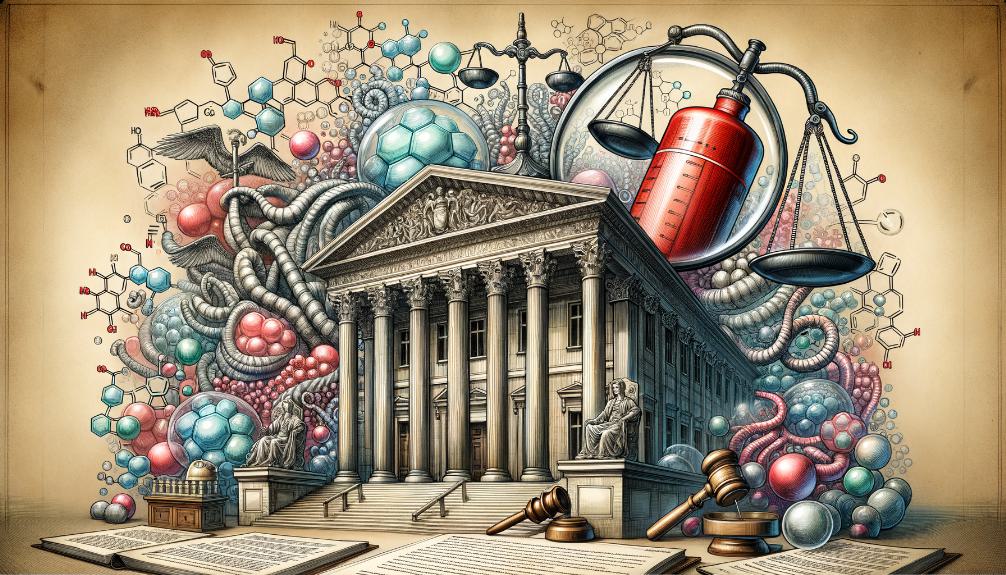
The legal landscape surrounding AFFF lawsuits is complex and evolving, marked by litigation efforts against chemical manufacturers. These legal actions, consolidated under multidistrict litigation in South Carolina, highlight the critical examination of the health impacts linked to PFAS chemicals in firefighting foams. This discussion will explore the litigation overview, key legal milestones, and plaintiff representation options, providing essential insights into the pursuit of compensation for affected individuals.
AFFF Litigation Overview
Within the realm of environmental and health-related litigation, AFFF lawsuits have emerged as an important battleground, with legal actions centered on the harmful effects of PFAS chemicals found in firefighting foams. The consolidation of these cases into a multidistrict litigation (MDL) in South Carolina has streamlined the legal process, allowing thousands of plaintiffs to collectively seek justice. Specialized firefighting foam attorneys are at the forefront, navigating the complex landscape to secure compensation for those affected by health risks associated with PFAS exposure. These lawsuits aim to hold manufacturers like DuPont and 3M accountable, emphasizing the need for reparation for individuals who have suffered due to the negligence of these corporations in managing the toxic impact of their products.
Key Legal Milestones
Numerous key legal milestones have shaped the evolving landscape of AFFF litigation, reflecting meaningful progress in addressing the consequences of PFAS exposure. Over 9,200 AFFF lawsuits have been consolidated into multidistrict litigation (MDL) in South Carolina, highlighting the extensive legal action against PFAS contamination. Recent settlements signal a move towards a potential global resolution, marking a pivotal moment in the fight for justice for victims, especially those suffering from testicular cancer. The strong evidential support in these cases has added complexity to the legal landscape, while second-tier payouts demonstrate a nuanced approach to compensation, offering higher sums for more severe injuries. This compensation guide aims to navigate the intricate legal proceedings, emphasizing ongoing efforts to resolve the health and environmental impacts linked to AFFF use.
Plaintiff Representation Options
Exploring the legal landscape of AFFF lawsuits reveals a variety of plaintiff representation options, with firms like Meirowitz & Wasserberg, LLP leading the charge in the national class-action suit. Centralized under the AFFF Firefighting Foam MDL in South Carolina, these legal proceedings aim to streamline the complex litigation process. This consolidation reflects the growing number of plaintiffs seeking justice for AFFF contamination's health impacts. DuPont, 3M, and other manufacturers are named defendants, highlighting the widespread accountability for the toxic chemicals associated with their products. Plaintiffs pursue compensation for exposure to these harmful substances, demonstrating the critical need for effective plaintiff representation in navigating the intricacies of AFFF-related legal challenges.
Key Elements of a Successful Claim

In the pursuit of a successful compensation claim for AFFF-linked testicular cancer, two pivotal elements stand out: proving the source of PFAS exposure and the importance of comprehensive medical documentation. Establishing a direct link between exposure to AFFF and the onset of testicular cancer is indispensable for a claim's success. Similarly, detailed medical records not only support the diagnosis and treatment but also serve as critical evidence of the impact of PFAS exposure on the claimant's health.
Proving Exposure Source
To establish a strong AFFF-linked testicular cancer claim, pinpointing the exact AFFF product involved and meticulously detailing the exposure's duration and intensity is paramount. A comprehensive account of the claimant's occupational history, especially if it includes firefighting or military roles where AFFF was handled, particularly bolsters the case. Medical records that indicate elevated PFAS levels or specific biomarkers tied to AFFF exposure are vital pieces of evidence linking the exposure source to the onset of testicular cancer. Additionally, expert testimony from toxicologists or environmental health specialists can elucidate the complex relationship between AFFF exposure and the development of testicular cancer. Establishing a clear narrative of how and when AFFF chemicals entered the body is crucial for substantiating the claim.
Medical Documentation Importance
After establishing the source of AFFF exposure, it becomes imperative to focus on the role of comprehensive medical documentation in substantiating a testicular cancer compensation claim. Detailed medical records, including a testicular cancer diagnosis and treatment history, are vital for linking AFFF exposure to the illness. Pathology reports are essential in confirming the cancer type, stage, and any relevant genetic factors, bolstering the compensation claim. Documentation of symptoms, treatment side effects, and their impact on daily life highlights the severity of the condition. Imaging studies such as ultrasounds or MRIs provide visual proof of tumors and metastasis, while consultation notes from healthcare providers offer insights into the treatment plan and prognosis. Together, these elements form the backbone of a persuasive compensation claim.
Documenting Exposure and Impact
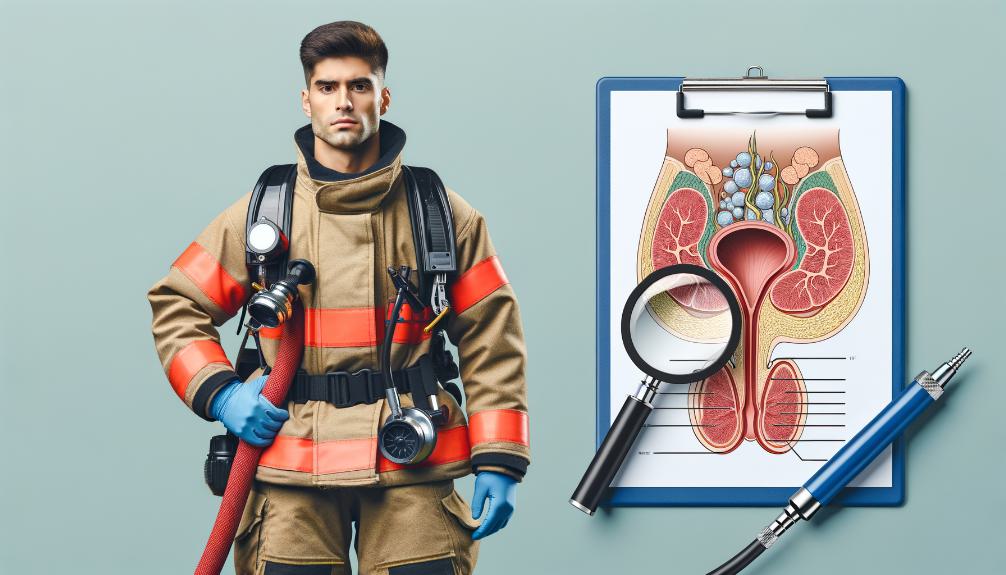
Documenting exposure to Aqueous Film Forming Foam (AFFF) and its subsequent impact on health is a critical step for individuals seeking testicular cancer compensation. This process often begins with establishing a clear connection between AFFF exposure and the development of testicular cancer, which can be challenging without thorough documentation. Evidence of occupational exposure, particularly in firefighting or military settings, is pivotal. Such documentation not only verifies the individual's exposure but also highlights the risk associated with their professional environment.
Medical records play a vital role in substantiating claims. These should detail the diagnosis, the extent of the disease, and the treatment regimen followed. The presence of medical records that clearly outline the diagnosis of testicular cancer and the subsequent health impacts provides a solid foundation for a compensation claim. Furthermore, proof of prolonged exposure, through firefighting history or military service records strengthens a claimant's case, emphasizing the duration and intensity of their AFFF exposure.
Additionally, gathering documentation related to AFFF-contaminated water sources near residences or workplaces can further support claims. This evidence can establish a direct link between an individual's living or working environment and their exposure to harmful chemicals.
Lastly, detailed records of the health impacts resulting from testicular cancer, including medical reports and treatment history, are indispensable. These documents not only demonstrate the severity of the condition but also highlight the physical, emotional, and financial toll it has taken on the individual. Collectively, this documentation forms the backbone of a compelling case for testicular cancer compensation linked to AFFF exposure.
Calculating Compensation Amounts

Determining the appropriate compensation amount for AFFF-linked testicular cancer cases involves a complex evaluation of several key factors, including the severity of the cancer and the length of exposure to toxic chemicals. Compensation amounts may vary significantly, ranging between $75,000 to $325,000, depending on these critical elements. The process is intricate, and designed to ensure fairness and adequacy in addressing the plaintiffs' suffering and financial burdens.
Settlement values in AFFF lawsuits are meticulously calculated, taking into account the extent of harm from exposure to toxic chemicals and the resulting medical expenses. These expenses not only include immediate treatment costs but also ongoing care and potential future treatments, reflecting the comprehensive impact of the exposure. Plaintiffs diagnosed with severe forms of testicular cancer and those with a history of long-term exposure to AFFF chemicals are typically placed in the top tier for compensation. This tiered ranking system ensures that the severity of the condition and the duration of exposure are proportionately reflected in the settlement amounts.
Furthermore, the calculation of compensation in AFFF testicular cancer cases also considers the high survival rate of testicular cancer. This factor impacts settlement values, as the prognosis and potential for recovery play a role in determining the financial compensation. The tiered ranking system is pivotal in this process, assigning higher tiers to more severe cases and those involving prolonged exposure scenarios. This systematic approach aims to deliver justice and support to affected individuals, taking into account the myriad of factors that influence the severity and impact of their condition.
Navigating Settlement Negotiations

Navigating settlement negotiations in AFFF-linked testicular cancer cases requires a precise understanding of the victim's exposure levels, the severity of their condition, and comprehensive medical documentation. These factors are critical in establishing a strong foundation for arguing fair compensation. The intricacies of these cases demand a thorough assessment of several key components, including the duration of PFAS exposure, detailed diagnosis, and the financial burden of treatment. These elements collectively inform the negotiation strategy and potential settlement amounts.
The process also heavily relies on the consideration of how testicular cancer has impacted the victim's quality of life, ability to work, and future health prospects. Settlement discussions are not solely about the immediate medical expenses but also about the long-term repercussions of the disease. Therefore, incorporating expert testimony and detailed medical reports is paramount to establishing a direct link between PFAS exposure and the development of testicular cancer.
Successful settlement negotiations hinge on the ability to present a well-documented case that highlights the severity of cancer, substantiates the extent of PFAS exposure, and clearly articulates the need for fair compensation. This includes a careful compilation of medical records, employment history, and personal testimonies to illustrate the profound impact on the victim's life.
AFFF Class Action Lawsuit Updates

As we navigate through the complexities of AFFF-linked testicular cancer claims, it's essential to stay updated on the latest legal developments within the class action lawsuit. Recent case consolidations and settlement predictions highlight the evolving landscape of litigation, providing essential insights into potential compensation amounts for affected parties. Understanding these updates can greatly influence the strategic approach to seeking justice and compensation for victims.
Latest Legal Developments
In recent developments, over 9,200 AFFF lawsuits have been consolidated in a class action MDL in South Carolina, signaling a substantial move towards a potential global resolution for settlements. This consolidation marks a pivotal moment in the legal landscape, as it brings together numerous claims under one umbrella for efficient processing. The focus on AFFF's link to testicular cancer has been a crucial element in strengthening the plaintiffs' cases. With settlement values varying based on illness severity and exposure duration, the implementation of a tiered ranking system serves as a comprehensive compensation guide. This system ensures that settlements are equitable, with top-tier payouts for testicular cancer cases ranging significantly. These latest legal developments represent a critical step forward in addressing the consequences of AFFF exposure and providing justice for affected individuals.
Compensation Amount Insights
Understanding the compensation amount insights for AFFF-linked testicular cancer cases reveals average settlement values ranging from $75,000 to $325,000, offering a glimpse into the financial outcomes for affected individuals. These figures reflect the intricate balance between the high survival rate of testicular cancer and the compensation awarded. The classification into compensation tiers is important, as it directly correlates with the severity of cancer and the duration of exposure to AFFF, ensuring that those with severe conditions and prolonged exposure are eligible for top-tier payouts. Recent settlements emphasize the industry's movement towards a potential global resolution, facilitated by mass tort agreements that prioritize a structured compensation framework. This framework is grounded in robust causation evidence, making the settlement values highly dependent on detailed exposure history, ensuring a fair and comprehensive assessment of each claim.
Seeking Expert Legal Assistance

Navigating the complexities of AFFF-linked testicular cancer litigation demands the expertise of qualified legal professionals. The intricate nature of these cases, including the scientific and legal challenges they present, requires a nuanced understanding that only expert legal assistance can provide. For individuals impacted by AFFF exposure, securing a skilled attorney is the first critical step toward achieving justice and obtaining fair settlements.
Qualified attorneys are instrumental in effectively navigating complex litigation procedures characteristic of AFFF-linked testicular cancer cases. These legal experts meticulously gather evidence, thoroughly assess damages, and vigorously pursue compensation on behalf of victims. Their profound knowledge and experience in dealing with similar cases enable them to develop compelling arguments and counter-defense tactics employed by the opposing side.
Moreover, legal representation is indispensable for victims seeking justice. Skilled attorneys play a vital role in maximizing compensation amounts, taking into consideration factors such as the severity of the illness and the duration of exposure to AFFF contaminants. Their strategic approach to litigation ensures that every aspect of the victim's suffering and financial losses are accounted for during settlement negotiations.
Seeking expert legal guidance particularly increases the chances of a successful outcome in AFFF-related testicular cancer compensation claims. Victims are thus empowered to navigate the legal system with confidence, knowing they have knowledgeable advocates fighting for their rights. Engaging a legal expert not only facilitates the pursuit of compensation but also underscores the importance of holding responsible parties accountable for their actions, thereby contributing to the broader effort of seeking justice for all affected individuals.
Moving Forward After Settlement

Securing a settlement for AFFF-linked testicular cancer marks a pivotal moment for survivors, allowing them to concentrate on their health and future well-being. The compensation received plays a critical role in providing the necessary financial support to cover the costs of medical treatments, ongoing care, and addressing the potential long-term effects of testicular cancer. It is an important step forward in ensuring that individuals have the resources needed to manage their recovery and safeguard their future health.
After the settlement, survivors must seek the counsel of financial advisors. This professional guidance can help in effectively managing the settlement amount, ensuring that funds are allocated wisely to cover future expenses, including any unforeseen health complications. Proper financial planning is essential in maximizing the benefits of the compensation received and in securing a stable financial future.
Furthermore, the journey to recovery extends beyond the physical aspects. Seeking emotional support and counseling post-settlement is vital in addressing the psychological impact of battling testicular cancer. The trauma associated with such a life-altering diagnosis can be profound, making emotional support an integral part of the healing process. Counseling services can offer a safe space for survivors to express their feelings and concerns, facilitating emotional healing.
Lastly, engaging in regular follow-up medical screenings and check-ups is paramount. These screenings are paramount in monitoring any potential recurrence of cancer or the emergence of health complications related to the initial treatment. Vigilance in follow-up care ensures that survivors can address any health issues promptly, maintaining their overall well-being.
Frequently Asked Questions
What Is the Average Payout for the AFFF Lawsuit?
The average payout for the AFFF lawsuit ranges from $75,000 to $325,000. This variation is influenced by factors such as the severity of cancer and the duration of exposure to AFFF contaminants.
Is There a Settlement for AFFF in 2023?
In 2023, settlements are underway for cases involving AFFF-linked testicular cancer. These settlements are part of a broader resolution with foam manufacturers, aiming to compensate affected individuals fairly based on exposure and severity of the condition.
What Are the Criteria for the AFFF Lawsuit?
The criteria for the AFFF lawsuit include occupational exposure to Aqueous Film Forming Foam (AFFF) and a confirmed diagnosis of testicular cancer, necessitating evidence of a direct correlation between exposure and the onset of the disease.
How Much Is the PFAS Settlement?
The PFAS settlement amounts vary, with compensation for AFFF-linked testicular cancer cases typically ranging between $75,000 to $325,000. Factors include severity and exposure duration, underpinned by strong causation evidence between AFFF and testicular cancer.
Conclusion
The correlation between AFFF exposure and an increased risk of testicular cancer necessitates comprehensive understanding and action. The available literature accentuates the importance of legal recourse for affected individuals, highlighting the complexities of litigation and the value of expert legal representation. As settlements emerge and legal frameworks evolve, victims must navigate these proceedings with informed strategies. This approach not only facilitates compensation but also contributes to broader efforts in addressing the environmental and health implications of PFAS contamination.




